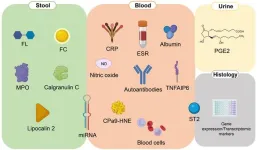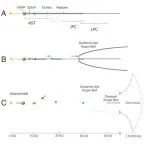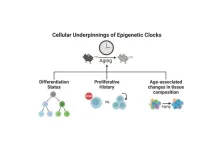Fecal, blood, and urinary biomarkers in inflammatory bowel diseases
2024-08-22
(Press-News.org)
The global burden of inflammatory bowel diseases (IBD), primarily Crohn's disease (CD) and ulcerative colitis (UC), continues to rise. Recent data show incidence rates of up to 17.8 cases per 100,000 person-years for CD and even higher for UC, reaching 28.4 per 100,000 person-years. These diseases primarily affect older populations and vary geographically, with higher prevalence rates in highly developed countries. Currently, endoscopic assessment through ileo-colonoscopy is the gold standard for diagnosing and monitoring IBD. However, this approach is invasive and often has limited availability, leading to long waiting times for patients. Consequently, the search for non-invasive biomarkers of disease activity has gained significant importance.
Biomarkers in IBD
Biomarkers are measurable compounds or substances that can be quantitatively evaluated in biological samples such as blood, urine, tissue, or feces. Recent research has focused on developing biomarkers that can assess disease activity, predict disease course, and monitor therapeutic response in IBD patients. The most relevant biomarkers studied include fecal calprotectin (FC) and C-reactive protein (CRP).
Fecal Calprotectin (FC)
FC is a cytosolic calcium and zinc-binding protein expressed by neutrophils and other immune cells. It is a stable protein that can persist in feces for up to a week, making it an ideal biomarker for non-invasive monitoring. FC has been extensively studied in IBD and has shown good-to-optimal correlation with endoscopic, histologic, and transmural disease activity. Several studies have reported high sensitivity and specificity of FC in differentiating IBD from healthy controls and functional gastrointestinal disorders. FC has also been shown to accurately predict endoscopic disease activity, reducing the need for colonoscopy in many cases.
C-reactive Protein (CRP)
CRP is an acute-phase reactant protein produced by the liver in response to inflammation. Its levels are often elevated in IBD patients, particularly during active disease phases. CRP has been used as a biomarker to monitor disease activity and predict treatment response. While CRP alone may not be as specific as FC, it can provide valuable information when combined with other biomarkers and clinical indices.
Multi-target Biomarkers
Research has also explored the potential advantages of using multi-target tools that combine serum and fecal biomarkers with clinical activity indexes. These tools aim to enhance diagnostic and monitoring effectiveness by providing a more comprehensive picture of disease status. Fecal lactoferrin, autoantibodies, microRNAs, gene expression, and other serological and fecal markers have shown promising results but require further validation before widespread adoption in clinical practice.
Clinical Implications
The implementation of the "treat-to-target" strategy in IBD management has heightened the significance of biomarkers. This approach involves meticulously pursuing multiple therapeutic objectives, which relies on periodic monitoring of markers of disease activity. Studies such as the CALM trial have demonstrated that promptly escalating treatment guided by both clinical symptoms and biomarkers yields superior clinical and endoscopic outcomes in IBD patients. The STRIDE-II consensus initiative has also emphasized the importance of clinical response, remission, endoscopic healing, and normalization of CRP/erythrocyte sedimentation rate and FC as primary therapeutic targets.
Conclusions
The incidence and prevalence of IBD continue to rise globally, necessitating the development of non-invasive diagnostic and monitoring tools. Fecal calprotectin and C-reactive protein are among the most relevant biomarkers studied in IBD, showing good correlation with disease activity and therapeutic response. Multi-target tools that combine biomarkers with clinical indices have also shown promising results. Further research is needed to validate these biomarkers and incorporate them into routine clinical practice to improve the management of IBD patients.
Full text
https://www.xiahepublishing.com/2994-8754/JTG-2024-00001
The study was recently published in the Journal of Translational Gastroenterology.
Journal of Translational Gastroenterology (JTG) dedicates to improving clinical diagnosis and treatment, advancing understanding of the molecular mechanisms, and promoting translation from bench to bedside of gastrointestinal, hepatobiliary, and pancreatic diseases. The aim of JTG is to provide a forum for the exchange of ideas and concepts on basic, translational, and clinical aspects of gastroenterology, and promote cross-disciplinary research and collaboration.
Follow us on X: @xiahepublishing
Follow us on LinkedIn: Xia & He Publishing Inc.
END
[Attachments] See images for this press release:


ELSE PRESS RELEASES FROM THIS DATE:
2024-08-22
When exactly does the aging process start? With the aging mechanisms unclear, no consensus has been reached about aging “cliffs”, where our body functions and biological processes just change dramatically, as if overnight.
In 2019, a study published in the authoritative peer-reviewed journal Nature Medicine, based on plasma proteomics data, identified 34, 60, and 78 years old as key time points of aging. In August 2024, Nature Aging, a Nature portfolio journal focusing on aging mechanisms, published the latest findings incorporating comprehensive data including transcriptomics and metabolomics, pinpointing the aging cliffs to the 40s and 60s.
In the biomedical field, multi-omics ...
2024-08-22
Non-living hydrogels can play the video game Pong and improve their gameplay with more experience, researchers report August 23 in the Cell Press journal Cell Reports Physical Science. The researchers hooked hydrogels up to a virtual game environment and then applied a feedback loop between the hydrogel’s paddle—encoded by the distribution of charged particles within the hydrogel—and the ball’s position—encoded by electrical stimulation. With practice, the hydrogel’s accuracy improved by up to 10%, resulting in longer rallies. The researchers say that this demonstrates ...
2024-08-22
The anti-cancer drug olaparib may be effective in treating biochemically recurrent prostate cancer without accompanying hormone therapy for men who have mutations in genes such as BRCA2, according to results of a phase II clinical trial of 51 patients conducted at the Johns Hopkins Kimmel Cancer Center and three other sites.
The study was done of men experiencing signs of cancer recurrence after surgical removal of the prostate, as measured by a high level of the protein prostate-specific antigen (PSA). Following treatment with olaparib, 13 participants, including all 11 who had BRCA2 mutations, had a decrease in PSA of at least 50% ...
2024-08-22
Tens of millions of Americans are being exposed to tobacco content on streaming services, according to new research from The University of Texas MD Anderson Cancer Center. The researchers found that the odds of encountering tobacco products being advertised, marketed or promoted on these platforms increased based on race, ethnicity, socioeconomic status and smoking habits.
The nationally representative study, published today in JAMA Network, revealed an estimated 12.4% of American adults were exposed to tobacco promotion on streaming services. Exposure was highest among those with a high school education or less (16.4%), Black/African American respondents (19.4%), ...
2024-08-22
About The Study: In two pivotal phase 3 clinical trials, elinzanetant, a selective neurokinin-1,3 receptor antagonist, demonstrated statistically significant reductions in vasomotor symptoms (VMS) frequency and severity vs placebo in postmenopausal individuals with moderate to severe VMS. Elinzanetant also significantly improved sleep disturbances and menopause-related quality of life vs placebo; the safety profile was favorable.
Corresponding Author: To contact the corresponding author, JoAnn V. Pinkerton, ...
2024-08-22
About The Study: In this repeated cross-sectional study of children’s exposure to food-related television advertisements, exposure via children’s programming decreased substantially. However, most advertisements seen were still for unhealthy products, and exposure from all programming remained substantial. Findings of more than 90% of advertising exposure not from children’s programming and more than 1,000 food-related advertisements seen per year suggest the need for government regulations based on time of day rather than programming.
Corresponding Author: To contact the corresponding author, Lisa M. Powell, PhD, email powelll@uic.edu.
To ...
2024-08-22
About The Study: In this study of the prevalence of exposure to tobacco advertisements on TV or streaming platforms among U.S. adults, disparities in exposure by race or ethnicity, education level, and smoking status were identified. These findings underscore the need for targeted public health interventions and regulation to address these disparities and reduce the impact of tobacco advertisements on vulnerable populations.
Corresponding Author: To contact the corresponding author, Sanjay Shete, PhD, email sshete@mdanderson.org.
To access the embargoed study: Visit our For The Media website at this link https://media.jamanetwork.com/
(doi:10.1001/jamanetworkopen.2024.27781)
Editor’s ...
2024-08-22
Thyroid hormone plays a key role in regulating a range of physiologic functions, including metabolism, temperature, heart rate, and growth. It accomplishes this impressive array of activities by interacting with almost every organ system in the body. Yet despite a long history of research on how thyroid hormone influences different organs, its effects on arguably the most crucial organ — the brain — have remained shrouded in mystery.
Now, scientists at Harvard Medical School have gained ...
2024-08-22
Higher thiazide doses are associated with greater reductions in urine calcium, which in turn correlate with fewer symptomatic kidney stone events, according to a Vanderbilt University Medical Center (VUMC) study published in JAMA Network Open.
Thiazide diuretics, commonly prescribed to prevent kidney stone recurrence, are drugs that act directly on the kidneys to promote diuresis (urine flow) by inhibiting the sodium/chloride cotransporter located in the distal convoluted tubule of a nephron ...
2024-08-22
How old are you, really? Your chronological age is the number of years you have been alive. Your biological age is how old your cells are which scientists believe may better assess one’s age-related health and disease risk. People biologically age at different rates, depending on genetic and environmental factors, so that a person’s chronological age does not necessarily match their biological age. In recent years, direct-to-consumer biological age tests have become increasingly accessible and popular as interest has increased ...
LAST 30 PRESS RELEASES:
[Press-News.org] Fecal, blood, and urinary biomarkers in inflammatory bowel diseases







